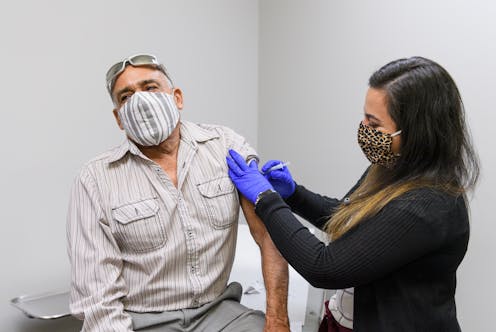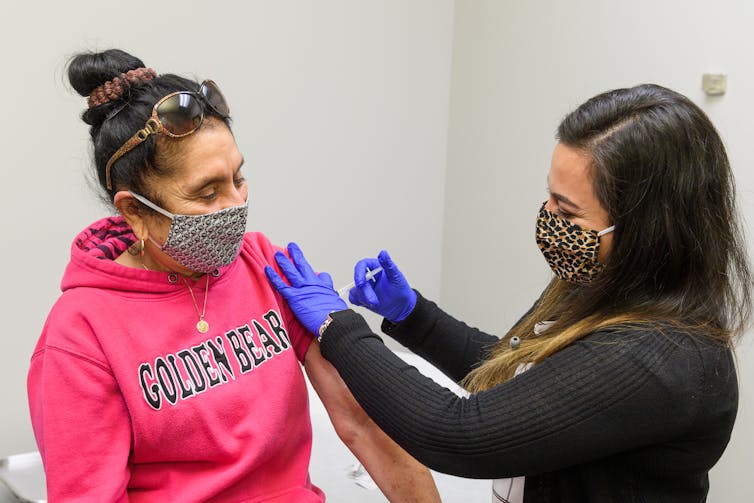Latinos are especially reluctant to get flu shots – how a small clinic in Indiana found ways to over
Millions of Latinos may not get the influenza shot this year, which could be an indicator of whether they will get a COVID-19 shot. A rural clinic shows how building trust can help overcome reluctance.

Every year, tens of millions of Americans avoid the flu vaccine. During the 2019-2020 flu season, fewer than half of U.S. adults got the shot.
The Latino population is more reluctant than most other groups to get the flu vaccine and often pays a high price with their health. An analysis by the Centers for Disease Control and Prevention of 10 flu seasons showed the Latino community had the third highest flu-related hospitalization rates of any demographic group.
As professors and researchers who study public health, we want to know why the Latino population, in particular, is so wary of the vaccine.
Here are a few reasons: Latinos worry about whether the shot is safe. They wonder if it works. They question whether it’s actually needed. Confidence in the vaccine is a major predictor of influenza vaccination among Latina women.
Getting a flu shot not only stops the spread of the flu. It might also be an indicator of who is willing to get a COVID-19 vaccine – and conversely, who is not, and why. So it is more important than ever to understand why large groups of people are reluctant to get vaccinated – and what might be done to earn their trust. We think our experience at a clinic in rural Indiana might shed some light on this important issue.
Historically low rates, despite high rewards
Reports from the 2019-2020 influenza season say that 38% of Latino adults were immunized, compared to 41% of Blacks, 42% of American Indian or Alaska Natives, 52% of Asians and 53% of whites. However, when children are included in the calculation rates, numbers for Latinos go up; Latino children are typically immunized with greater frequency than their parents.
Those receiving the shot have fewer lost work and school days. They reduce the risk of seeking medical intervention by 40% to 60%. That includes visits to crowded emergency rooms. In communities with known influenza virus circulation, vaccinations decreased pediatric hospitalizations by 41%. For adults, vaccines reduce the likelihood of admission to an intensive care unit by 82%.
Those with the lowest influenza vaccine rates are also disproportionately affected by COVID-19. Since both illnesses show some of the same symptoms, testing is needed to distinguish one disease from the other. This will divert health care personnel from other tasks. Hospitals already crowded with COVID-19 patients will be asked to make room for those with severe influenza.
This is particularly important this year, as health care providers scramble to prevent the possible “twindemics” of influenza and COVID-19. Even during normal times, the Latino community may be at increased risk of exposure to the flu virus; many have jobs in crowded work environments, like meat packing plants, warehouses and agriculture enterprises.
[Get the best of The Conversation, every weekend. Sign up for our weekly newsletter.]
A rural community steps up
The Family Health Clinic in Monon, Indiana, a rural community in White County, Indiana, has worked to build trust with the local Latino population by taking some relatively simple steps. The clinic, recognized by the U.S. government as a place that provides high-quality care to a traditionally underserved population, is staffed by nurse practitioners. Partnering with the Purdue University School of Nursing, the Family Health Clinic serves a clientele that is 52% Latino.
One important part of gaining trust was in making sure the staff were bilingual. Other strategies the clinic used to establish relationships with the Latino population included sponsoring community activities and inviting Latino participation on the clinic board. Perhaps of most importance was generating a reputation for providing a secure, affordable and respectful place for excellent health care in a setting where staff listened to and responded to questions about vaccines.
Brenda Andrade is one of the many who recently received her influenza shot there. She has five children, ranging in age from 4 months to 9 years. Andrade was willing to receive a shot because she wanted to “make sure her family is protected.”
Two more local residents, Juan and Elidia Miranda, also made the flu shot a priority. “We’ve gotten colds every so often, but not influenza,” said Juan Miranda. After talking with clinic staff, they realized the benefits of staying healthy for themselves and their families.

Community health centers like the Monon clinic have long been a trusted source of care for those who don’t otherwise have health care access. They are more than equipped to handle the reasons often given by Latinos as to why they don’t get the shot. But will this willingness to receive the flu vaccine from a trusted source translate to receiving the COVID-19 vaccine when it’s available?
The answer is likely yes. A history of having taken other vaccines is a significant predictor of future behavior, as is a vaccine recommendation from one’s trusted health care provider. Monon clinic staff have already initiated discussion of the rationale for being vaccinated, sharing available safety and efficacy data with patients.
The authors do not work for, consult, own shares in or receive funding from any company or organization that would benefit from this article, and have disclosed no relevant affiliations beyond their academic appointment.
Read These Next
West Antarctica’s history of rapid melting foretells sudden shifts in continent’s ‘catastrophic’ geo
A picture of what West Antarctica looked like when its ice sheet melted in the past can offer insight…
How the ‘slayer rule’ might play a role in determining who will inherit wealth from Rob Reiner and h
These rules have a long history in the United States. They played a role in the notorious murders by…
From truce in the trenches to cocktails at the consulate: How Christmas diplomacy seeks to exploit s
World leaders like to talk up peace at Christmastime. But alongside the tales of seasonal breaks in…






